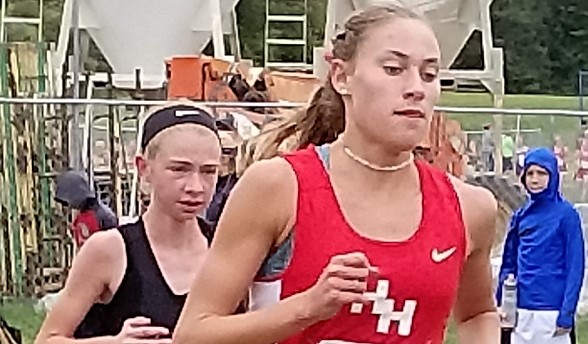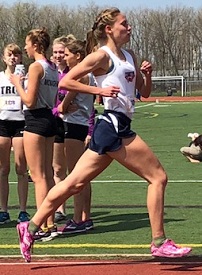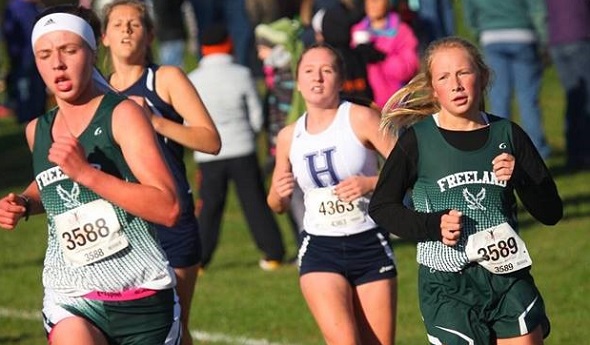
Performance: Hanover-Horton's Judy Rector
September 13, 2018
 Judy Rector
Judy Rector
Hanover-Horton senior – Cross Country
The Hanover-Horton senior has returned from injury to become a two-time MHSAA Finals track champion, and she’s surged into her senior cross country season pacing among the state’s elite in that sport as well. Rector ran a personal-record 18:07.7 on Saturday to win the Class 3 race at Bath’s Bret Clements Invitational and also best the winners of the event’s two larger-school races, earning her the first Michigan Army National Guard “Performance of the Week” for 2018-19.
Saturday was the second time in four races this fall that Rector lowered her personal record, and she’s now dropped 37 seconds from her fastest finish of 2017. As a sophomore, Rector began suffering from slipping rib syndrome – one of her ribs would pop out of place, causing intense pain. She was forced to take six months off from running and missed her track & field season that spring while undergoing physical therapy. She ran again for the first time on the day of the 2017 MHSAA Track & Field Finals, built back her strength for cross country last fall and finished 10th in Lower Peninsula Division 3, and then won the 800 and 1,600-meter LPD3 track championships this spring.
 Rector’s winning time at Bath bested the lineups from the top-ranked teams in both LPD1 and LPD2, plus racers from five more teams ranked among the top 10 in those divisions. She’s got big goals for the rest of this senior year. She’s aiming to run 17:30, which would break the school cross country record set by 2012 graduate Lindsey Burdette, and finish top-three at this fall’s Finals and qualify for the Foot Locker national competition. Next spring, she’ll try to repeat in the 800 and 1,600 and make a run at the 3,200 as well. With only one A- scratching an otherwise perfect academic record, Rector is carrying a 3.99 grade-point average, tied for sixth in her graduating class. She’s still figuring out where, but she’s planning to study biology and continue her running career at the collegiate level.
Rector’s winning time at Bath bested the lineups from the top-ranked teams in both LPD1 and LPD2, plus racers from five more teams ranked among the top 10 in those divisions. She’s got big goals for the rest of this senior year. She’s aiming to run 17:30, which would break the school cross country record set by 2012 graduate Lindsey Burdette, and finish top-three at this fall’s Finals and qualify for the Foot Locker national competition. Next spring, she’ll try to repeat in the 800 and 1,600 and make a run at the 3,200 as well. With only one A- scratching an otherwise perfect academic record, Rector is carrying a 3.99 grade-point average, tied for sixth in her graduating class. She’s still figuring out where, but she’s planning to study biology and continue her running career at the collegiate level.
Coach Dean Blackledge said: “We knew we had a special athlete when she was a freshman. The only one who didn't know was Judy. It took her a while to really understand she's as good as she is. A year and a half ago she was really in the dumps, the whole thing, because she couldn't run. … (But) we worked though the difficult times for her, spent an awful lot of time together, and she got it. When she did finally get through it, she just blossomed into the runner that I always thought she was going to be. She’s just tough in training and self-discipline. When you talk about a cross country runner, the main thing more than in probably any other sport is a cross country runner has to be self-disciplined. They have to get up and run five or six or 10 miles or whatever when other kids are sleeping or whatever, and they have to do that year-round almost. She’s been that kind of athlete. When we do a workout we go out on the roads sometimes to run, and they can cut corners whenever they want and the coach would never know. I don’t think Judy has ever cut a corner. … She’s just a great leader. She has humility, and it’s tough to get an athlete as good as she is that doesn’t boast about themselves. If you want to know something about Judy, you have to talk to somebody else. She won a couple of state championships in equestrian, and I didn’t know that until 2-3 weeks ago – and I’ve been her coach, been close to her, and she’s never said a word about it.”
Performance Point: “My goal going into (Bath) was actually to try to get under 18 (minutes),” Rector said. “Last year when we ran at Bath, I didn't run very well. I was really sick, so this year I wanted to put up a good time because I knew from last year that it was a good course to run. Fortunately it was a lot cooler in the morning, a lot better running weather than we had earlier that week on Wednesday. I was like, we're going to try to maintain a 5:45 split, which would put me just under 18. I have a tendency to go faster at the beginning of my races, and I thought if I tried to even-split it more that it would be better. At the 2-mile I was at 11:35, 11:40, so I knew I was running well at that point. It was just trying to finish going into the last mile. I knew where I was at time-wise, but more than anything I kept seeing my teammates, like the last mile. There were the boys and some of the JV girls – every time I saw them, it makes it easier to keep going. Your teammates are there and they're cheering you on, and they want you to do well. That picked me up a lot for the last part of the race too.”
Comeback trail: “For me, that was a really hard thing. Before I got injured, running was something I enjoyed and I was fairly good at. But when you're supposed to be going to rehab and doing all of those things, you really have to put yourself into it 110 percent. When they ask you to do things like the exercises and stuff, I was like, This is crazy. No way.’ They're like, it will help you. ... Having goals helped me because I'm a really goal-driven person. So coming out of that and not being able to run, I knew I valued it a lot more, just being able to go outside and being able to run and having the ability to do that because some people don't even have that. Having it in my head that I didn't want to take anything else for granted – every time I did a workout or went out to run, it was the best effort that I could do.”
 Finding form: “Last summer was just trying to build up to where I was in the high 18s. This (spring’s) track season was huge for me and getting me the confidence that I could be running faster, not just short distance things but cross country too. Over the past year I've worked a lot on my form and a lot more on basic strength, the little things that I didn't necessarily do before. So I feel a lot more smooth when I'm running.”
Finding form: “Last summer was just trying to build up to where I was in the high 18s. This (spring’s) track season was huge for me and getting me the confidence that I could be running faster, not just short distance things but cross country too. Over the past year I've worked a lot on my form and a lot more on basic strength, the little things that I didn't necessarily do before. So I feel a lot more smooth when I'm running.”
Back on track: “After taking all of that time off, I started running on the day of the (track) state meet a year ago – so it would've been a full year from not being able to run to starting running, to the day I won those two championships. It was really emotional. I never would've imagined being able to do all of that in a year. ... It had always been a goal I had to maybe run and win a state championship, but that I was able to do it, in that amount of time, I was just so happy and proud.”
Future path: “(I’d like to become) a pathologist, someone who researches and studies diseases. I really like science classes. Last year I took a microbiology class that was more based on studying diseases, and we took samples of things from around our school and looked at them and ran tests on them, and I thought was super cool. If I could do something like that or in the medical field, that's a long-term goal for me.”
- Geoff Kimmerly, Second Half editor
Every week during the 2018-19 school year, Second Half and the Michigan Army National Guard will recognize a “Performance of the Week" from among the MHSAA's 750 member high schools.
The Michigan Army National Guard provides trained and ready forces in support of the National Military Strategy, and responds as needed to state, local, and regional emergencies to ensure peace, order, and public safety. The Guard adds value to our communities through continuous interaction. National Guard soldiers are part of the local community. Guardsmen typically train one weekend per month and two weeks in the summer. This training maintains readiness when needed, be it either to defend our nation's freedom or protect lives and property of Michigan citizens during a local natural disaster.
PHOTOS: (Top) Hanover-Horton's Judy Rector leads the way during a race this fall. (Middle) Rector powers down the straight-away during the Track Finals this spring. (Photos by Joe Childs and Marlissa Shepherd, respectively.)

Freeland Girls Realizing Fast-Pace Potential
By
Paul Costanzo
Special for MHSAA.com
August 14, 2019
Runners on the Freeland girls cross country team had no idea how good they could be a year ago, mainly because most of them were entering their first year in the program.
 Two of the Falcons’ newly formed top seven – Kiera and Peyton Hansen – had just moved into the district from Ogemaw Heights. Three others – Whitney Farrell, Allyson Harvey and Mara Longenecker – were freshmen.
Two of the Falcons’ newly formed top seven – Kiera and Peyton Hansen – had just moved into the district from Ogemaw Heights. Three others – Whitney Farrell, Allyson Harvey and Mara Longenecker – were freshmen.
“Everyone was kind of new,” said Peyton Hansen, who is now entering her senior year. “My sister and I were new, and there were a lot of incoming freshmen, so it was a blank slate, and that made it easier for us all to get along and work together. That’s what kick-started us to performing very well. You’re not going to want to train and run with people every day if you don’t like them.”
The Falcons got to know each other and got to know their immense talent throughout the season, winning a Regional title and finishing 15th at the MHSAA Lower Peninsula Division 2 Finals. Now six of the top seven are back, and hopes are high for the upcoming season.
“I think it was Regionals, because we weren’t really supposed to win that, but we did and that’s when we realized we could really be good,” sophomore Mara Longenecker said. “Before then, we didn’t really realize it. I think we can definitely go to states again as a team, and hopefully place in the top 10 this year.”
As far as preseason proclamations go, Longenecker’s is fairly mild considering what she and her teammates already have done and what they bring back.
With a tough conference season ahead – Tri-Valley Conference rival Frankenmuth also qualified for the Finals a year ago and could bring back six of its top seven racers – and a region that features Frankenmuth, Corunna and Flint Powers Catholic, nothing is guaranteed. But the numbers are in their favor.
Kiera Hansen was an all-state performer, Saginaw County and Regional champion as a freshman, clocking in with a personal best of 18 minutes, 32.7 seconds. Farrell and Peyton Hansen each were sub-20 runners last year, while Harvey (20:07.9), juniors Caitlyn Mieske (21:10.8) and Longenecker (21:12.7) weren’t far behind.
Of the 14 teams that finished ahead of Freeland at the 2018 Finals, only four (champion East Grand Rapids, Petoskey, St. Johns and Cadillac) are expected to return six of their top seven runners.
 Only one other school in the top 15 (Otsego, which placed ninth with two seniors leading the way) had four freshmen in the lineup at the Finals.
Only one other school in the top 15 (Otsego, which placed ninth with two seniors leading the way) had four freshmen in the lineup at the Finals.
“I think that we gained a lot of experience,” Farrell said. “We all didn’t run our best times at that race, but now we know the course and it can be a bit more familiar. There was a ton of people; it was really crazy.”
But modesty is something coach George Drown said runs throughout the team, whether that’s in setting individual goals, team goals or even applying to be one of the team’s captains this season.
“I don’t know if it’s that they don’t want the pressure, so they’re not expressing they know how good they are, but I do think they’re slowly understanding that,” said Drown, who is entering his third season at Freeland. “I think they’re excited for the season and excited for the new challenges we face with a different conference. We go from the team that was the darkhorse in the Regional to the team that has a target on their back.”
While the girls on the team said they didn’t see the success coming prior to last year, Drown did. His wife is the middle school coach in Freeland, giving him extra insight into the upcoming talent. And even though he’s fairly new to Freeland, he spent the previous 10 years coaching in nearby Hemlock.
“I think we did see it coming up,” Drown said. “Did we think they were going to be as good as they were their freshman year? No. But they bought in. We train to make the team good. We did a lot of group runs, and we had times with Kiera and Whitney where we knew they could run faster, but we held them back, and we used our top two girls to elevate our three through six and really pull them through the longer workouts. They bought in, and that’s how we did it. We really focused on the thought the team is only as good as the sum of its parts.”
Drown said his team is capable of stretching well beyond the top seven this season when it comes to being competitive at the varsity level, predicting he has 14 girls who are capable of running a 5K in less than 22 minutes.
So while the hopes are high and the season figures to be competitive, perhaps the modesty at the top of the lineup comes from knowing no breaks can be taken, even in practice.
“It’s really good for me, because I have people to base off of how fast I should be going,” said Longenecker, who joins Mieske as a team captain. “I’m never by myself on a run. I don’t want to say it’s a competition, but it really is at practice. You don’t want to finish last.”
 Paul Costanzo served as a sportswriter at The Port Huron Times Herald from 2006-15, including three years as lead sportswriter, and prior to that as sports editor at the Hillsdale Daily News from 2005-06. He can be reached at [email protected] with story ideas for Genesee, Lapeer, St. Clair, Sanilac, Huron, Tuscola, Saginaw, Bay, Arenac, Midland and Gladwin counties.
Paul Costanzo served as a sportswriter at The Port Huron Times Herald from 2006-15, including three years as lead sportswriter, and prior to that as sports editor at the Hillsdale Daily News from 2005-06. He can be reached at [email protected] with story ideas for Genesee, Lapeer, St. Clair, Sanilac, Huron, Tuscola, Saginaw, Bay, Arenac, Midland and Gladwin counties.
PHOTOS: (Top) Freeland’s Allyson Harvey, right, and Peyton Hansen pace a pack around a bend during a race last season. (Middle) Whitney Farrell, left, and Kiera Hansen also were among Freeland’s top runners in 2018. (Photos courtesy of the Freeland girls cross country program.)

